
Chapter 3. Installing the 3ESP
3.1 First encounters
3.1.1 Unpacking
The 3ESP seismometer is delivered in a single transportation case. The packaging is specifically designed for the 3ESP and should be reused whenever you need to transport the sensor. Please note any damage to the packaging when you receive the equipment, and unpack on a safe, clean surface. The package should contain:
The seismometer
A breakout box (which provides separate connections for the signal, control and power lines)
A cable to join the sensor to the breakout box;
Hand-held Control Unit (HCU) for monitoring sensor outputs and calibration, if ordered;
10-pin connector for your power lead
Calibration and installation sheet.
Assuming all the parts are present, stand the seismometer in the centre of a bench and identify its external features:
Handle with North indication,
26-pin connector for input and output,
Bubble level,
Air vent port,
Three adjustable feet
Two accurate orientation pins (one brass and one steel).
3.1.1.1 Serial number
The sensor's serial number can be found on the label stuck to the top lid of the sensor. It is also stamped onto the side of the sensor base, next to the N/S indicator, and into the lid itself. You should quote this serial number if you need assistance from Güralp Systems.
3.1.1.2 Handling notes
The 3ESP is a sensitive instrument, and is easily damaged if mishandled. If you are at all unsure about the handling or installation of the device, you should contact Güralp Systems for assistance.
Caution: Do not bump or jolt any part of the sensor when handling or unpacking.
Caution: Do not kink or walk on the data cable (especially on rough surfaces such as gravel), nor allow it to bear the weight of the sensor.
Caution: Do not connect the instrument to power sources except where instructed.
Caution: Do not ground any of the signal lines from the sensor.
Caution: Do not move the instrument whilst the masses are unlocked. You should report any sign of loose components, or any sound of parts moving inside the instrument, to Güralp Systems.
3.1.2 Connections
The instrument has a 26‑pin connector which can be joined using the cable provided to a digitizer or breakout box. Individually shielded twisted-pair cabling must be used for the sensor outputs, control lines and power supply. If you need to make up a suitable cable, you should confirm the cable type with Güralp Systems.
Connector pin-outs are given in Appendix A on page 38.
3.1.2.1 Using a digitizer
The 3ESP can be connected directly to any Güralp Systems digitizer using the signal cable provided. This is the simplest way to use a 3ESP instrument. All the instrument's functions are available through the digitizer, including centring, and in instruments equipped with the option, remote locking and unlocking.
We recommend that you keep the digitizer near the instrument if at all possible, to minimize the length of analogue cable required. Once digitized, the signal is robust to degradation by noise or attenuation. Keeping the digitizer in the quiet, stable conditions of a seismic installation also provides it with an optimum environment for the on-board ADCs.
3.1.2.2 The breakout box
This unit separates the lines in the signal cable, so you can connect a power supply, a recording system, and the hand-held control unit:
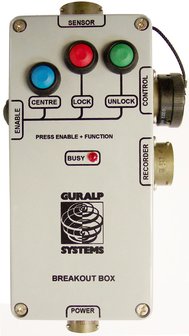
You can also use the breakout box to centre the sensor masses. If your 3ESP includes the remote locking and unlocking option, you will be supplied with a slightly different breakout box with additional buttons for locking and unlocking the masses.
The standard breakout box is rain resistant but not waterproof. If you intend to use a breakout box in your installation, you should site it away from potential flooding. If this is not possible, a larger unit is optionally available which can be immersed in water without damage. (The 3ESP itself is, however, completely waterproof.)
3.1.2.3 Power supply
The sensor requires a 12 V power supply, which it obtains through the socket and breakout box or digitizer. You will need to make up a suitable cable to connect a 12 V power source to the 10-pin connector on the breakout box (spare 10-pin mil-spec connectors are provided for this purpose.) Using a 12 V, 25 Ah sealed heavy-duty lead-acid battery, you should expect the instrument to operate for around a week without recharging.
If you prefer, you can power the 3ESP directly from the connector on the top panel (see Appendix A on page 38).
A power management module can be installed as an option, which allows the 3ESP to operate from a 10 – 15 V supply range. This module also cuts the input power to the sensor electronics if it drops below 10.5 V, to minimize discharge from battery-operated installations.
The 3ESP draws a nominal current of 75 mA from a 12 V supply when in use. During locking and unlocking of the sensor masses, this current rises briefly to 600 mA. It is recommended that you carry a spare 12 V battery when visiting an installation for maintenance, in case the sensor needs to be moved and the on-site batteries no longer have sufficient charge to perform the locking procedure.
3.1.2.4 Signal output
The sensors output voltages representing ground velocity on floating differential lines. The breakout box provides a RECORDER connector for attaching to a recording system or digitizer. You can use any multi-channel recording system, provided that it has high-impedance floating differential inputs.
If you are using a Güralp Systems digitizer, you can connect the instrument directly to the digitizer without using the breakout box; power will be supplied through the digitizer, which can also activate the sensor control lines.
The breakout box also provides a CONTROL output, which can be connected to the Hand-held Control Unit. This device lets you monitor output signals from the instrument, and perform on-site calibration. For more information, see Section 5.1, page 28.
3.2 Installation notes
The goal of any seismic installation is to ensure that wave-trains arriving at the instrument accurately reflect the internal motion of subsurface rock formations. To achieve this, the seismometer and its emplacement need to be considered as a mechanical system, which will have its own vibrational modes and resonances. These frequencies should be raised as high as possible so that they do not interfere with true ground motion: ideally, beyond the range of the instrument.
In particular, the sensor needs to be protected against environmental factors such as
Fluctuations in temperature
Turbulent air flow around walls or trees, or around sharp corners or edges in the immediate vicinity of the sensor
Vibration caused by equipment in or near the installation, particularly computer equipment
Vibration caused by heavy machinery (even at a distance), or by overhead power lines
In seismic vaults, instruments are often installed on piers. It is important to ensure that the interface between the pier and the floor does not introduce noise, and that the pier itself does not have resonant frequencies within the passband. Ideally, a seismic pier will be significantly wider than it is high (to minimize flexing) and will form a single piece with the floor, e.g. by moulding a poured concrete floor with a wooden frame.
Many situations do not allow for the construction of a seismic vault. For example, you may need to deploy quickly to monitor the activity of a volcano showing signs of rejuvenation, or to study the aftershocks of a major earthquake; or the site itself may be too remote to ship in construction equipment.
Temporary installations can be protected against spurious vibrations by
Selecting a suitable site
Placing the instrument in a protective enclosure (an open-sided box of 5 cm expanded polystyrene slabs, placed over the instrument and taped down to exclude draughts, makes an excellent thermal shield)
Standing the sensor on bedrock where possible, or at least deep in well-compacted subsoil
Clearing the floor of the hole of all loose material
Using as little extra mass as possible in preparing the chamber
After installation, the instrument case and mounting surface will slowly return to the local temperature, and settle in their positions. This will take around four hours from the time installation is completed. If you require long-period recording, you should re-zero the instrument after this time.
3.3 Installing in vaults
You can install a 3ESP in an existing seismic vault with the following procedure:
Unpack the sensors from their container, saving the shipping boxes for later transportation.
Prepare the mounting surface, which should be smooth and free of cracks. Remove any loose particles or dust, and any pieces of loose surfacing. This ensures good contact between the instrument's feet and the surface.
If it is not already present, inscribe an accurate North-South line on the mounting surface.
Place the sensor over the scribed line, so that the brass and steel pointers are aligned with the marked directions, with the brass pointer facing North. This can be done by rotating the base of the sensor whilst observing it from above. The brass pointer can be found next to one of the feet:
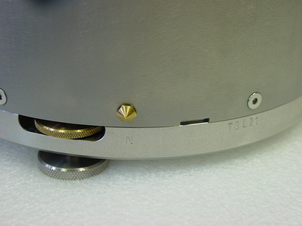
If you cannot easily see the pointers, you should align the sensor using the north arrow on the handle. However, the alignment of the handle with the sensors inside is less accurate than the metal pointers, so they should be used wherever possible.
The top panel of the 3ESP includes a spirit level:
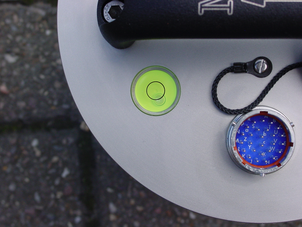
Level the sensor using each of the adjustable feet of the instrument in turn, until the bubble in the spirit level lies entirely within the inner circle. (The instrument can operate with up to 2 ° of tilt, but with reduced performance).
The feet are mounted on screw threads. To adjust the height of a foot, turn the brass locking nut anticlockwise to loosen it, and rotate the foot so that it screws either in or out. When you are happy with the height, tighten the brass locking nut clockwise to secure the foot. When locked, the nut should be at the bottom of its travel for optimal noise performance.

Connect the sensor to the breakout box or a Güralp digitizer if you are using one.
Connect a 12 V power supply either directly or through the breakout box or digitizer.
If your 3ESP instrument has the standard, manual mass control system, three sockets on the casing of the 3ESP allow each mass to be locked and unlocked. Locate the socket corresponding to the vertical sensor mass.
Otherwise, skip to step 16.
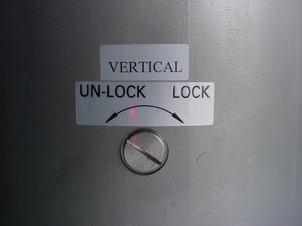
Remove the pressure cap from the socket.
Carefully insert a 3 mm hex driver into the casing, allowing it to be guided into the conical socket on the sensor housing within. The inner sockets are not precisely aligned with the holes in the casing, since their position is determined by the fixed component. Use the diagram below to help you locate the socket.
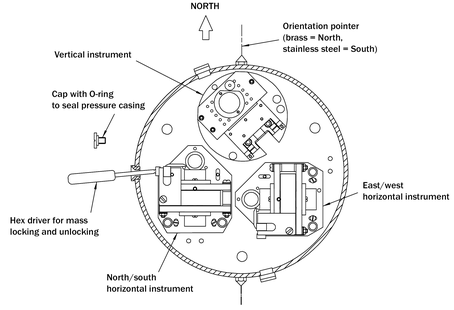
Turn the driver anticlockwise to unscrew it.
After this point, you should be careful not to tilt the instrument, or you may damage it.
Clean the pressure cap and apply a thin layer of molybdenum disulphide grease to the O-ring and mating surfaces.
Install the pressure cap. Do not over-tighten.
Repeat steps 8 – 13 for the north/south and east/west components.
Check the mass position outputs using a digital multimeter, digitizer or the hand-held control units.
If your instrument has the optional automatic mass control system, unlock the sensor masses by holding the ENABLE and UNLOCK buttons on the breakout box or hand-held control unit down together for 7 seconds. The BUSY LED will start flashing, and then go out. The unlocking process may take a minute or longer.
Alternatively, if you are using a DM24 digitizer and Scream!, right-click on the digitizer's entry in Scream! and select Control.... Click on the Mass control tab, followed by Centre.
Alternatively, if you are using a DM24 digitizer and a DCM, navigate to the Actions → Digitizer Setup → Port x page for the digitizer and click on the Centre instrument button at the bottom of the page. (If the Mass control tab is unavailable, make sure the correct sensor type is chosen in the Sensor type tab, apply, and open a new Control window.)
Otherwise, if your instrument does not have this option, skip this step.
Re-centre the masses if required. If you have a breakout box or hand-held control unit, you can do this by holding the ENABLE and CENTRE buttons on the unit down together for 7 seconds. The BUSY LED will start flashing, and then go out.
If you are using a DM24 digitizer and Scream! or a DCM, you can also access the CENTRE function from the Mass control or Digitizer Setup windows as described above.
Cover the instrument with thermal insulation, for example, a 5 cm expanded polystyrene box. This will shield it from thermal fluctuations and convection currents in the vault. It also helps to stratify the air in the seismometer package. Position the thermal insulation carefully so that it does not touch the sensor package.
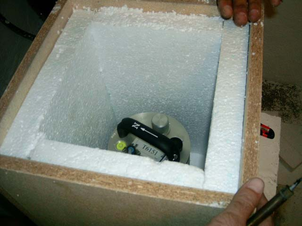
Ensure that the sensor cable is loose and that it exits the seismometer enclosure at the base of the instrument. This will prevent vibrations from being inadvertently transmitted along the cable.
3.4 Installing in pits
For outdoor installations, high-quality results can be obtained by constructing a seismic pit.
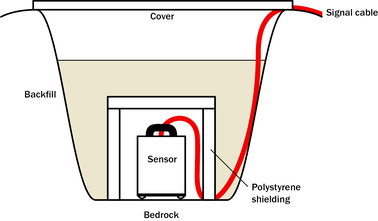
Depending on the time and resources available, this type of installation can suit all kinds of deployment, from rapid temporary installations to medium-term telemetered stations.
Ideally, the sensor should rest directly on the bedrock for maximum coupling to surface movements. However, if bedrock cannot be reached, good results can be obtained by placing the sensor on a granite pier on a bed of dry sand.
Prepare a hole of 60 – 90 cm depth to compacted subsoil, or down to the bedrock if possible.
On granite or other hard bedrock, use an angle grinder to plane off the bedrock at the pit bottom so that it is flat and level. Stand the instrument directly on the bedrock, and go to step 7.
On soft bedrock or subsoil, you should install a pier as depicted below.
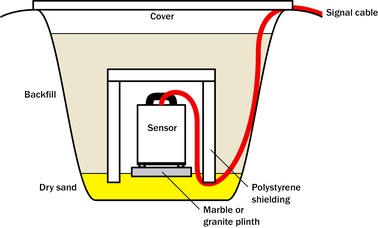
Pour a layer of loose, fine sand into the pit to cover the base. The type of sand used for children's sand-pits is ideal, since the grains are clean, dry and within a small size range. On top of the sand, place a smooth, flat granite plinth around 20 cm across, and shift it to compact the sand and provide a near-level surface.
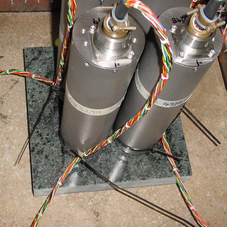
Placing a granite plinth on a sand layer increases the contact between the ground and the plinth, and improves the performance of the instrument. There is also no need to mix concrete or to wait for it to set, as in step 4.
Alternatively, if time allows and granite is not available, prepare a concrete mix with sand and fine grit, and pour it into the hole. Agitate (“puddle”) it whilst still liquid, to allow it to flow out and form a level surface, then leave to set. Follow on from step 7.
Puddled concrete produces a fine-textured, level floor for placing the seismometer. However, once set hard, the concrete does not have the best possible coupling to the subsoil or bedrock, which has some leeway to shift or settle beneath it.
Alternatively, for the most rapid installation, place loose soil over the bottom of the pit, and compact it with a flat stone. Place the seismometer on top of this stone. This method emulates that in step 3, but can be performed on-site with no additional equipment.
Set up the instrument as described in the previous Section.
The instrument must now be shielded from air currents and temperature fluctuations. This is best done by covering it with a thermal shield.
An open-sided box of 5 cm expanded polystyrene slabs is recommended. If using a seismic plinth on sand (from steps 3–4 or 5), ensure that the box is firmly placed in the sand, without touching the plinth at any point. In other installations, tape the box down to the surface to exclude draughts.
Alternatively, if a box is not available, cover the instrument with fine sand up to the top.
The sand insulates the instrument and protects it from thermal fluctuations, as well as minimizing unwanted vibration.
Ensure that the sensor cable is loose and that it exits the seismometer enclosure at the base of the instrument. This will prevent vibrations from being inadvertently transmitted along the cable.
Cover the pit with a wooden lid, and back-fill with fresh turf.
3.4.1 Other installation methods
The recommended installation methods have been extensively tested in a wide range of situations. However, past practice in seismometer installation has varied widely.
Some installations introduce a layer of ceramic tiles between a rock or concrete plinth and the seismometer (left):
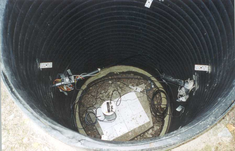
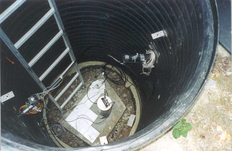
However, noise tests show that this method of installation is significantly inferior to the same concrete plinth with the tiles removed (right). Horizontal sensors show shifting due to moisture trapped between the concrete and tiling, whilst the vertical sensors show 'pings' as the tile settles.
Other installations have been attempted with the instrument encased in plaster of Paris, or some other hard-setting compound (left):
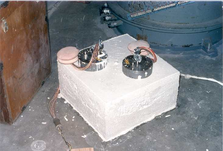
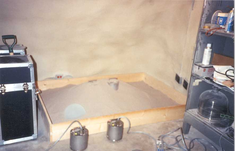
Again, this method produces inferior bonding to the instrument, and moisture becomes trapped between the hard surfaces. We recommend the use of fine dry sand (right) contained in a box if necessary, which can also insulate the instrument against convection currents and temperature changes. Sand has the further advantage of being very easy to install, requiring no preparation.
Finally, many pit installations have a large space around the seismometer, covered with a wooden roof. Large air-filled cavities are susceptible to currents which produce lower-frequency vibrations, and sharp edges and corners can give rise to turbulence. We recommend that a wooden box is placed around the sensor to protect it from these currents. Once in the box, the emplacement may be backfilled with fresh turf to insulate it from vibrations at the surface, or simply roofed as before.
By following these guidelines, you will ensure that your seismic installation is ready to produce the highest quality data.
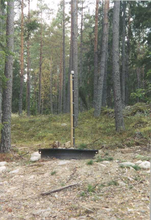
3.5 Installing in post-holes
The 3ESP is suitable for installation in post-holes. In soft subsoil, a hole 2 – 4 m deep and 20 cm wide can be conveniently excavated using a tractor-mounted or hand-operated post-hole auger. To minimize surface effects, you should ensure that the hole is at least 1 m deeper than the length of the instrument, and preferably somewhat more.
Since the hole has no lining, it may occasionally flood. However, most soil types are sufficiently permeable to allow water to soak away, leaving the packing material moist.
To install a 3ESP in a post-hole:
Clean the post-hole, making sure there is no loose material around the mouth of the hole or on its base.
Prepare the instrument package, making sure the inclinometer is visible, and attach it to a winch or hoist by clamping a light steel cable to the centre of the handle so that the package hangs vertically. Connect the signal cable to the instrument.
Add packing material to the hole to about 15 cm depth. Fine crushed rock, with a high proportion of rock flour and fine particles, makes excellent packing material. Alternatively, a mixture of 3 mm grade angular coarse grit with around 30% medium grit gives good results. Moisten the packing material in the hole and ram firm.
Lower the instrument to the bottom of the hole, but without slackening the lifting cable.
Fill more packing material around the instrument for about 30 cm, moisten, and ram firm.
Use the inclinometer to check that the instrument remains within its tilt tolerance (± 2 °).
Continue filling, moistening and packing until the instrument is buried, checking that the tilt remains within tolerance.
Release the strain on the lifting cable, and allow the packing material to settle for 24 hours.
If all is well after the settling period, release the lifting tackle, coil a tail of the lifting wire into the top of the hole and backfill almost to the surface.
Ensure that the signal cable is slack, and fix it to a support at the top of the hole.
Ram a split wooden bung into the top of the hole, and cover with sandbags.
Attach the signal cable to your recording equipment or breakout box. Carry out preliminary tests using a hand-held control unit, if required.